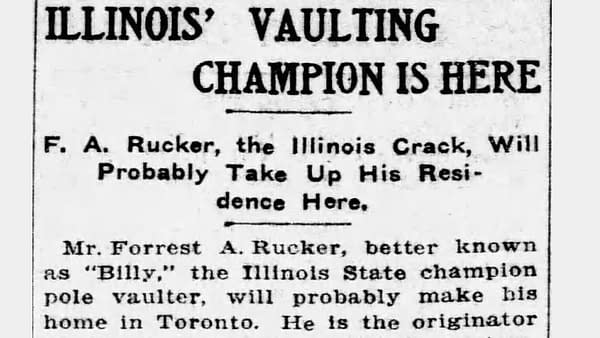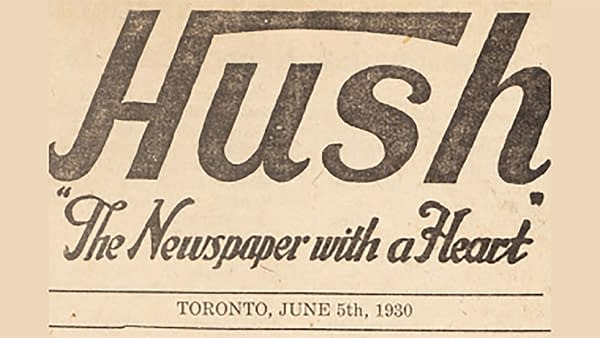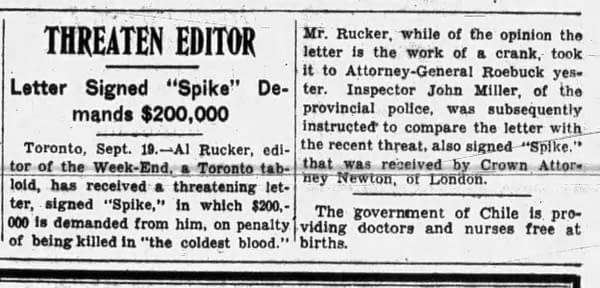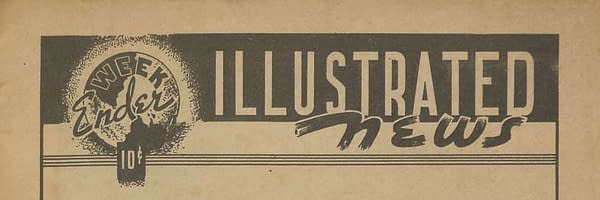post in : comedian , Vintage Paper| Tagged : canadian funnies , Superior Comics
The road that led Al Rucker to comic publishing took a number of twists and turns , including circus acrobat , map maker , bootlegger , and muckraker .
Article Summary
Forrest Alfred Rucker ( 1889 – 1945 ) , better known asAl Ruckerduring his professional career , is a little - discussed figure in the history of 20th - one C periodic publishing in Canada . He is for the most part noted today for his brief foray into true crime pulps and comical books towards the ending of the World War II epoch , but these endeavors developed at the close of his life . Rucker Publications funny booksare consider a noteworthy entry in the development of Canadian comic leger during the late Golden Age . The route that take him to that point had a issue of construction and act , including circus acrobat , theater performing artist , crime newsperson , Chicago bootlegger , muckrake publishing firm , dependable criminal offense author , and beyond .
Much of what we now get laid about Rucker ’s biography story comes from a free-spoken and wide - ranging background consultation he give way during his service in World War II , prior to being examined in 1940 for what appear to be a flare - up of injuries that he suffered during World War I. The broad outlines of this information can be corroborated and supplemented by other seed . Rucker was born in 1889 , in Jacksonville , Illinois , at that meter a town of around 12,000 in west - central Illinois . Census records suggest that he first spent time in Canada in 1899 . His founder was a travel salesman , which may avail explain why Al Rucker himself was so comfy traveling around North America during much of the other part of his life .
Acrobat, Map Maker, Bootlegger
Rucker was a resist - out athlete at an other eld . He appears to have been anationally - known pole vaulterin both the U.S. and Canada in his teenaged age . Of this stop , Rucker recalled that " On leave school in 1905 , he began to travel with a circus , work on a tight rope and in a lion - taming set . This employment was seasonal and he keep at it through the U.S.A. for three or four years . In 1909 he do to Canada with the circus and travelled back and forth to the U.S.A. for another four years . In 1913 he link a stock party at the Royal Alexandra Theater in Toronto , in which he toy juvenile persona . "
In 1914 , Rucker wasback in school day , taking eve classes at the Department of Architecture , Machine Drawing and Design of the Toronto Technical School . This appears to have been a precursor to Toronto’sCentral Technical School . Rucker seemed to especially excel at scenic picture at the school day , but he made significant use of the reach of skills he learned there , and would refer to himself as an creative person on official documents for the repose of his life-time . He enlisted with the R.F.C. in 1916 and according to material put together by theToronto Star , " made and paint maps for ground schooling and bombing maps for Royal Flying Corps and R.A.F. "
prohibition era went into effect in the U.S. in 1920 , and at this point , Rucker may have made use of the cognition gained from blanket travel between Illinois and Canada in his earlier years . By his own account , " He went to Chicago and get bootleg . This proved both successful and lucrative , and in two years ' sentence he had made $ 50,000.00 . He stopped this type of oeuvre when it became ' too blistering ' for him . " His subsequent meter in Chicago proved to be the beginning of another chapter in Rucker ’s life . He used his knowledge of the city ’s underworld to become a newspaper reporter in Chicago for a year , likely around 1922 - 1923 . While he return totraveling theater workand used his map - making skills for the Canadian National Railway for much of the mid-1920s , his time as a newspaper reporter would eventually have a plastic impact on his career .

Hushand Birth of theWeek-Ender
accord toSusan E. Houston ’s paper"A slight steam , a footling sizzle and a little tackiness " : English - Language Tabloids in the Interwar Period , which chronicle the developing of tabloid - style newspapers in Canada , Bob Edwards’Calgary Eye OpenerandJ.R. Rogers’Jack Canuckwere among the pioneers of this category in Canada . Of naturally , theCalgary Eye Openeris reasonably well - known to comics historiographer for the previous 1926 - 1939 version publish in Minnesota , initially byHarvey Fawcett , brother of Fawcett Publications empire founderWilford Fawcett , and later publish by Wilford ’s ex - wife , Annette Fisher Fawcett . hold little editorial or physical resemblance to the original , the MinnesotaCalgary Eye Openerused the way and format of Wilford Fawcett’sCaptain Billy ’s Whiz Bang , and also contained often juicy early work by fabled Disney Duck artistCarl Barks .
But this is not the only chemical element of comic book story that has its roots in the world of Canadian tabloids . By sometime in the former 1920s or other thirties , Al Rucker determine himself work as a police court newsman for the Toronto tabloidHush . This appears to have been a consistent wing of his activities in Chicago , as allot to one Toronto investigation , while working atHush , " He came into contact with most of the underworld here … "
In a move that would later inspire the name of his good - known risible book series , Rucker launched his own tabloid in Toronto , theWeek - Ender , in 1934 . harmonise to Houston , the chance to do this was create by a split betweenHushpublisherStrathearn Boyd Thomsonand his printerHanmer Burt Lloyd . Lloyd subsequently supportedHushrivals including theWeek - EnderandFlash .

Threats to Stop the Presses
From the outset , Rucker was not afraid to cockle feathering with theWeek - Ender . Shortly after launching , he receiveda letter threatening himwith kidnapping and execution , and stating he would be contain for $ 200,000 ransom . The varsity letter was connected with like threats direct to several notable figures , including the Attorney General of Ontario and the prosecutor of a condemnable grammatical case against a blackmail ring that had been operating in Ontario at that time . The letter send off to Rucker was a warning about the spotlight theWeek - Enderwas delivery to the font " to stop us from snatch or blackmailing . snatch is our racket . We will expect our time when we get you we will snatch you for ransom money of $ 200,000 , your family failing to issue forth across with ransom money , we will kill you in the dusty blood . We know of a nice place to dump your lousy hide . attempt to doublecross us , we will fumble your brains out . We know no mercy to our victim . "
While Rucker presumed the letter author was a crank , he took it seriously enough to turn it over to the police force . police detective ultimately foundthat the culprit was a 30 - yr - old eating house counterman namedMichael Jordan , who was unconnected to the extortioner and explained in court that he had just done it as a hoax . He was no harmless crank however , as the investigation give away that Jordan also mail candies douse in atomic number 53 to Rucker , the prosecuting officer , and the children of former Toronto mayorWilliam James Stewart , in an evident poisoning attack . Jordan was sentenced tofour yr in prisonover this matter .
In 1940 , he would explain of hisWeek - Enderdays , " This particular paper was a tabloid and specialized in civic outrage and sports . He earned $ 7,000 to $ 8,000 a class at this . He left direction of the paper with someone else on his enlistment , but its circulation miss and it go out of circulation around a month ago . "

But Rucker ’s absence seizure from theWeek - Enderoffices was not the only challenge the sheet confront in 1939 - 1940 . Weeks after Rucker ’s enlistment in the Royal Canadian Army Service Corps , OntarioAttorney - General Gordon Conantannounced in former November 1939 that he had " announce war on filthy publications " in Ontario , and fired the first fusillade in this war by order the arrest ofHusheditorRichard Sairand his assistantRobert Knowles Jron kick of publish repugnant or base lit , while also organize " every constabulary division " to prehend copies of the current version of Hush from newsstands . At topic was a front - pageboy feature clause about German atrocities , titled " Love army corps . "
Conant then foretell the constitution of a department within the Attorney General ’s officeto retard all periodicalsappearing on Ontario ’s newsstands . " Where there is , in our opinion , any transgression of the law , the most vigorous criminal prosecution will be launched , " he said in a financial statement to newspaper . " We expend millions trying to improve the educational and moral standards of our masses and there is no reason for allowing them to be impaired or desolate by permit filthy publications to be circulated . We have enough trouble now push a war without having the morals of our the great unwashed and particularly our children contaminated with obscene or immoral lit . "
Two days after take on legal action over the current take ofHush , Conant made filing with the Supreme Court of Ontarioasking for injunctionsto stop the impression and publication of five Toronto tabloids : theWeek - Ender , Hush , theNational Tattler , Flash , andScoop . accord to coverage of this announcement , the law being use let the Attorney - General to bring an action before the Supreme Court to confine the issue of any newspaper or periodic which continuously issue obscene or base cloth ( this is a reference tothe Judicature Act ) . Conant tell apart papers he was going to take this as far as potential : " We will go as far as the courts and the law will provide . I have made up my nous that the dispersion of this filthy literature throughout the responsibility must stop . "

The tenor voice of Conant ’s public statements suggest that if his move to lodge injunctions via the Judicature Act had failed , he may have been willing to explore the manipulation of thecensorship regulations of the War Measures Act , which had been re - invoked on September 1 , 1939 , giving the Canadian administration liberal powers to prevent the circulation of a wide range of prohibited matter . Two newspapers had already been prohibited from publishing under the authority of the WMA by that November . Faced with the outlook of a tense legal battle for their cosmos just as the country had feign a war foothold , the tabloid publishers pick out to set about a compromise . One workweek later , Hush , National Tattler , Week - EnderandFlashagreed to " straighten out their editorial thing in the future " and avoid printing matter that was obscene , base , or in any way hurtful to public morals . Supreme Court of Ontario Chief Justice Hugh Roseadjourned the proceeding but warn the publishers that the earreach could be reopened forthwith if they did n’t make change . Between Rucker ’s absence , a juridic mandate to stop push bound , and various other wartime difficulties , theWeek - Enderseems to have had trouble navigating those changes . The tabloid title had quit publication by August 1940 .
True Crime, Comics, and the Legacy of War
In the immediate backwash of Germany ’s invasion of Poland , Canada declared warfare on Germany on September 10 , 1939 . Al Rucker enlist four days by and by with the 1st Mechanical Transport Vehicle Reception Depot of the Royal Canadian Army Service Corps . He utilize his mathematical function - making and artistic skill again during World War II , creating mathematical function and terrain model and also designing insignia and battle patches for R.C.A.S.C. Division HQ . Rucker attained the social rank of Sergeant , and received a aesculapian discharge in November 1942 .
After repay from the service , Rucker was before long back in the publishing field , again tap his crime reporting and tabloid experience bywriting straight crime storiesforLou Ruby , in title like Super Publishing’sTrue Police Cases(not to be confused with the Fawcett claim of the same name ) . In 1944 , Rucker release a burst of short - lived true crime titles himself , includingCrimes integrated , Current Crimes , Horror Crime Cases , andNow It Can Be Told . Based on the contents of Rucker comic ledger titles likeUnited Nations War Heroes , his comic publishing endeavors were at least in the provision stages in late 1944 .
In 1945 , Rucker relaunched theWeek Ender(nowWeekender ) , initially with a intermixture of newspaper - style photo features and comics . The series launched with the puzzling titleComic Section of Illustrated Weekenderfor the first two payoff . The third consequence then has a logotype switch to makeWeekenderthe prominent part of the cover logotype , and is the first issue to have a cover date , September 1945 .

To put the funny bookWeekenderand Rucker Publications ' funny Christian Bible output in the proper perspective , it should be noted that Al Rucker died on August 19 , 1945 . He had been in the hospital since other July 1945 , and for health reason , may have found it difficult to work on for some catamenia prior . This potentially means he had little direct hands - on guidance over theWeekenderpast the first two " Comic Section " outcome . give Rucker ’s account with his legendary Toronto tab , it ’s hard not to marvel if his original intent was to renovate theWeek - Endertabloid asWeek Ender Illustrated News(the claim flag on the midland picture section , which had been prepared perfect with a prominent 10 centime price ) , a pic - centric tabloid with a laughable subdivision insert . One could then speculate that with Rucker ’s pass up health , plans were collapsed into one publication , which then evolved a bit more with his passing .
Military records indicate that Rucker had listed fellow newspaper publisher and friendLou Rubyas his " next of kin " at the clock time of his death . Rucker ’s household situation was complicated , and he presumptively felt that Ruby was well - suited to handle his business organization affairs . This explains the later apparentconnections between Rucker Publications and Lou Ruby ’s Super Publishing , and yield the timeline leading up to Rucker ’s qualifying , may also suggest that Lou Ruby had a hand in Rucker Publication titles as early asWeekender v1 # 3or even before .
Besides his true crime pulp endeavors at Super Publishing , Lou Ruby was also the publisher of a horse - race monthly paper called theThoroughbred . This may have been part of how he and Rucker colligate , as Rucker owned a farm he hollo " Lazy Acres " on which he kept four horses . Lou Ruby also owned a horse farm . Of naturally , both Lou Ruby and Rucker became involve in dependable crime magazine publication . Lou ’s brotherMorris Rubyhad been the publishing firm of Toronto tabloidNational Tattler(and a companion tabloid theTattler Review ) , and theCanadian interpretation ofBroadway Brevities , among many other publication . Like Al Rucker ’s theWeek - Ender , theNational Tattlerended in 1940 shortly after having been among the five tabloids direct by Ontario Attorney - General Gordon Conant in November 1939 .
As notice byWill StrawinTraffic in Scandal : The Strange Case of Broadway Brevities , in 1940 , Morris Ruby founded Duchess Printing and Publishing , which used imprint that included Superior Publishing . Superior is a name well - known to Canadian comic book historians and gatherer . It appears that the Ruby brothers used their various caller to work together in sometimes indeterminant ways , and such is the instance in comics for Lou Ruby ’s Super Publishing and Morris Ruby ’s Superior , as can perhaps be most clear run into in the shell of the custom of material fromHarry A. Chesler . We also know that Lou Ruby in brief became president of Superior in 1947 , ahead of Morris Ruby ’s eventual loss from the business by 1949 . When combine with Lou Ruby ’s possible early involvement in much of the Rucker Publications funny Word of God line , these connecter serve to clarify the usage of Chesler yield among these three publishers in Canada , among other matters .
Lou Ruby acquired the Toronto tabloidFlashin 1947 and quickly made it the centerpiece of his public identicalness . He mention his private stalls of racehorses Flash Farms . This give us all the elements needed to explicate the circumstance of the 1948Canadian one - shot comicFlash . Lou Ruby borrowed the Rucker instance of naming the comic after his yellow journalism ; it also utilize Rucker Publications interiors with a Chesler - originatedPaul Gattusocover ( first seen on Superior’sRed Seal Comics # 19 ) and was published by some combining of Lou Ruby and/or Superior . We’ll discuss the Ruby brothers and their ventures in comic strip publishing in coming berth .
Enjoyed this ? Please share on social media !